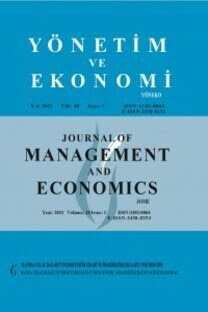Firma Davranışlarının Yan Etkilerini Ayrıştırmak: COVID-19'u İthal Ettik Mi?
Türkiye'deki şehirlerde COVID-19 ve ilişkili ölümlerin erken dönemdeki varlığı uluslararası ticaret hacmi ile açıklanabilmektedir. Çin ile ticaret pandemi üzerinde şehirlerin toplam dış ticaretinden daha yüksek etkiye sahiptir. Çin ile thalat, ihracat ve toplam ticaret ilişkilerinin etkisi arasındaki sıralama pandeminin hangi aşamasında olunduğuna göre değişebilmektedir. Çin ilişkilerin pek çok ülke tarafından durdurulduğu dönemde ülke ile devam eden ticaretin vaka sayıları üzerinde etkisi artmaktadır. Anahtar Kelimeler: COVID-19, Şehir Bazlı Veri Analizi, Uluslararası Ticaret JEL Sınıflandırması: C21, R15, F14, F68
Anahtar Kelimeler:
COVID-19, Şehir Bazlı Veri Analizi, Uluslararası Ticaret
Discriminating Between the Side Effects of the Firm Behavior: Did We Import COVID-19?
Early COVID-19 presence and related deaths in Turkish cities can be explained by their international trade volume. Trade with China has a higher impact on the pandemic against the total international trade of cities. The ordering between imports, exports and total trade with China varies depending on the stage of the pandemic. As the China were sealed off by many countries, continuing international trade with the country has increasing impact on the case numbers. Key Words: COVID-19, City-level Data Analysis, International Trade. JEL Classification: C21, R15, F14, F68
Keywords:
COVID-19, City-level Data Analysis, International Trade,
___
- Anatolian Agency. (2020). Retrieved from: https://www.aa.com.tr/tr/koronavirus/saglik-bakani-koca-turkiyede-ilk-koronavirus-vakasinin-goruldugunu-acikladi/1761466
- Aydogan, Y. (2020). A Microeconomic Analysis of the COVID-19 Distribution in Turkey. Bingöl Üniversitesi İktisadi ve İdari Bilimler Fakültesi Dergisi, 4(2), 11-25.
- Birenbaum-Carmeli, D., & Chassida, J. (2020). Covid-19 in Israel: socio-demographic characteristics of first wave morbidity in Jewish and Arab communities. International Journal for Equity in Health, 19(1), 1-13.
- Casini, L., & Roccetti, M. (2020). A Cross-Regional Analysis of the COVID-19 Spread during the 2020 Italian Vacation Period: Results from Three Computational Models Are Compared. Sensors, 20(24), 7319.
- Ehlert, A. (2020). The socioeconomic determinants of COVID-19: A spatial analysis of German county level data. MedRxiv.
- Jošić, H. (2020). The socio-economic catalysers of COVID-19 pandemic. Croatian Review of Economic, Business and Social Statistics, 6(2), 12-26.
- Krisztin, T., Piribauer, P., & Wögerer, M. (2020). The spatial econometrics of the coronavirus pandemic. Letters in spatial and resource sciences, 13(3), 209-218.
- Sha, D., Malarvizhi, A. S., Liu, Q., Tian, Y., Zhou, Y., Ruan, S., ... & Yang, C. (2020). A State-Level Socioeconomic Data Collection of the United States for COVID-19 Research. Data, 5(4), 118.
- Stojkoski, V., Utkovski, Z., Jolakoski, P., Tevdovski, D., & Kocarev, L. (2020). The socio-economic determinants of the coronavirus disease (COVID-19) pandemic. arXiv preprint arXiv:2004.07947.
- United Nations Comtrade Database. (n.d.). UN Comtrade: International Trade Statistics [Data Set]. https://comtrade.un.org/data/
- Valero, M., & Valero-Gil, J. N. (2020). Determinants of the Number of Deaths from COVID-19: Differences between Low-Income and High-Income Countries in the Initial Stages of the Pandemic. Available at SSRN 3617049.
- Varkey, R. S., Joy, J., Sarmah, G., & Panda, P. K. (2020). Socioeconomic determinants of COVID‐19 in Asian countries: An empirical analysis. Journal of Public Affairs, e2532.
- Wu, J.T., Leung, K., Bushman, M. et al. (2020). Estimating clinical severity of COVID-19 from the transmission dynamics in Wuhan, China. Nat Med. https://doi.org/10.1038/s41591-020-0822-7
- Zeren, F , Yılancı, V . (2020). Analysing Spatial Patterns of the COVID-19 Outbreak in Turkey. Bingöl Üniversitesi İktisadi ve İdari Bilimler Fakültesi Dergisi, 4 (2), 27-40. https://doi.org/10.33399/biibfad.789117
- ISSN: 1302-0064
- Başlangıç: 1995
- Yayıncı: Manisa Celal Bayar Üniversitesi
